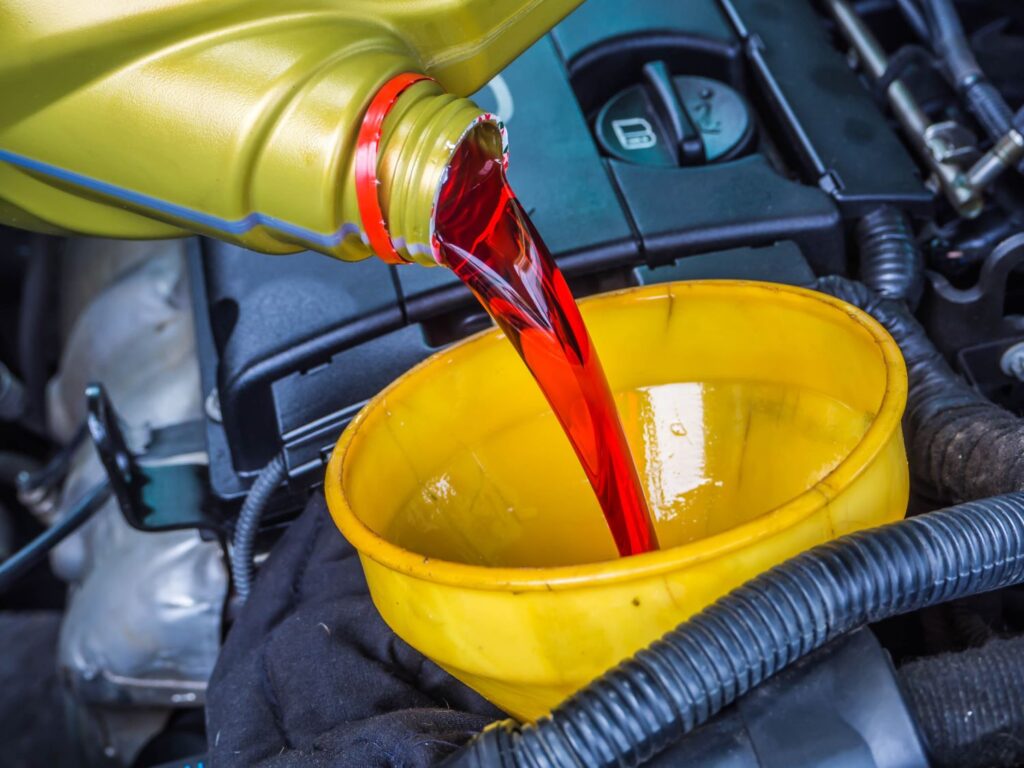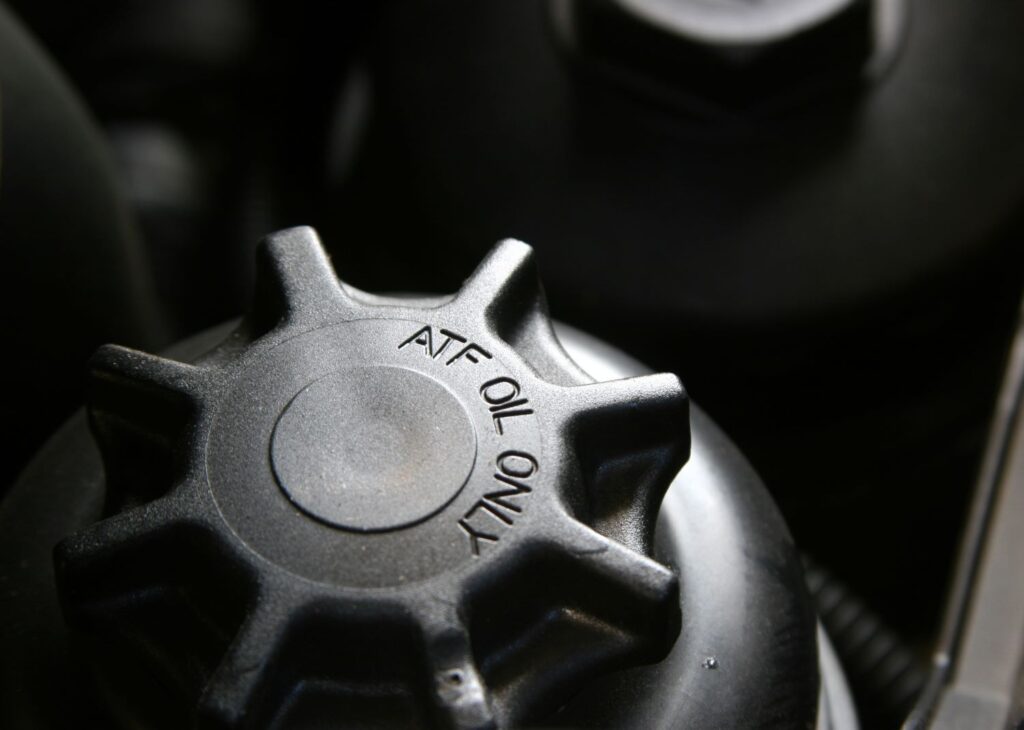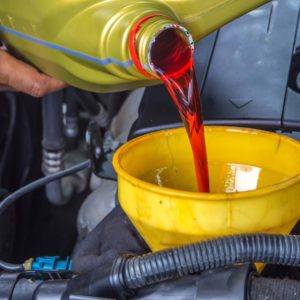Whether you drive an automatic or manual vehicle, its transmission relies on transmission fluid to run smoothly. It’s important to learn what transmission fluid is, what it does, and its different types so that you can understand your vehicle’s engine better.
What Is Transmission Fluid?
Every vehicle has a transmission, archaically referred to as a “gearbox,” that transfers power from the engine through the final drive and differential to the wheels.
An automatic transmission shifts your vehicle into the correct gear when changing speed or direction based on speed, load, and throttle angle. A manually shifted transmission requires more skill from the driver in selecting the right gear and making the shift. Manual transmissions are filled with oil or transmission fluid, but only as a lubricant.
Manual transmissions have no fluid pump like an automatic transmission does, nor does the fluid pass through a heat exchanger (transmission fluid cooler).
Manual transmissions use various different types of fluid. While some use 50W oil, most use fluids that are thinner. Some manual transaxles even use automatic transmission fluid. Using a fluid that is too thick or viscous in a manual transmission can cause gear clash while shifting.
Whether the gearbox is manual or automatic, it needs transmission fluid. However, in an automatic transmission, the fluid does a lot more than simply lubricate the transmission’s internal parts.

What Does Transmission Fluid Do?
In both automatic and manual transmissions, the transmission fluid’lubricates gears, bearings and shafts, and also prevents components from overheating.
However, automatic transmissions use fluid for hydraulics as much as for lubrication. An automatic transmission has a fluid pump that fills the torque converter with fluid pressure and provides line pressure to the transmission’s valve body to move little spring-loaded valves that direct the fluid to apply stacks of clutches to transfer power.
These clutch pack assemblies enable the transmission input shaft that comes from the torque converter turbine to drive components connected to the elements of planetary gear sets. This is how most automatic transmissions achieve all their gear ranges and reverse.
Bands and braking clutches in the automatic transmission will, when applied, hold stationary certain elements connected to the planetary gears. Except for mechanical one-way clutches in the transmission, these brakes and bands are also applied with hydraulic pressure from the fluid pump using the transmission fluid.
What Type of Transmission Fluid Does Your Vehicle Need?
The type of transmission fluid your vehicle needs will depend on what type of gearbox it has. There are two main types of transmission fluids, manual transmission fluid (MTF) and automatic transmission fluid (ATF). However, there are also synthetic and specialty fluids for specific models, such as continuously variable transmissions (CVT) and dual-clutch vehicles.
Almost all automatic transmissions have a torque converter that is designed to lock the spinning torque converter shell to the turbine for optimum fuel economy. While earlier torque converter lockup clutches were either applied or released, modulated torque converter clutches became the order of things beginning in about 1990.
A modulated clutch is designed to have a controlled slip, so that the converter can be applied by percentages from zero to 100 percent locked.
Automatic Transmission Fluid
First of all, if you’re doing the transmission service yourself, make sure you use the right fluid for that vehicle. CVT transmissions require a special kind of fluid that is usually different from the other types.
Most vehicles in the US have an automatic transmission and need automatic transmission fluid. ATF lubricates the gears and prevents the transmission from overheating. Automatic vehicles generate more heat than manual vehicles, so ATF has greater heat resistance and thermal stability than other transmission fluids. This prevents the formation of sludge during high temperatures and prevents clutch glazing. ATF also functions as a hydraulic fluid that powers the transmission.
First of all, if you’re doing the transmission service yourself, make sure you use the right fluid for that vehicle. CVT transmissions require a special kind of fluid that is usually different from the other types.
–Richard McCuistian, ASE Certified Master Automobile Technician

There are different types of ATF oils depending on grading and quality. Here are a few examples:
- Dexron Automatic Transmission Fluid: Developed by General Motors (GM), Dexron is a synthetic-based ATF with improved antifoam quality, oxidation resistance, and fluid-nylon compatibility. It’s one of the most common fluids in the market today.
- Mercon Automatic Transmission Fluid: Mercon is a highly friction-modified fluid used by most Ford, Lincoln, and Mercury vehicles. It was first developed by Ford before the company allowed other manufacturers to produce it according to their specifications.
- Multi-Vehicle Transmissions ATF: Multi-Vehicle is a synthetic-based fluid compatible with most automatic transmissions, including those that require earlier variants of Dexron fluid.
- Type F Transmission Fluid: Type F is a non-friction modified ATF used in early band-type automatic transmissions. It’s mostly used for earlier Ford vehicles, especially those manufactured before the 1980s.
What is the best ATF oil for your vehicle? Check the owner’s manual, where you’ll find this information. Most manufacturers have specific recommendations for the vehicle’s fluid type and change interval.
Manual Transmission Fluid
Nowadays, manual transmissions use different oils. Some use regular motor oil, while some even use ATF. However, earlier models with a manual transmission usually use manual transmission fluid. MTF is heavier, darker, and smells stronger than ATF. But again, some manual transaxles use ATF, so make sure you use the right fluid if you’re filling a manual transmission or you may create issues.

Transmission Fluid FAQs
How Do You Know If You Need Transmission Fluid?
Contrary to popular belief, transmission fluid is not eternal. Over time, it can break down, become contaminated, or leak from the transmission system. It’s important to check your vehicle’s transmission system and look out for any signs that you need a fluid change.
If you need a change in transmission fuel, you’ll notice performance issues when shifting gears. You’ll hear a chattering sound when starting the car and a roaring sound when you accelerate or suddenly change direction. You might even smell something burning. Another sign to look out for is a puddle under your car, which is most likely from a leak. If you notice any of these symptoms, be sure to check your transmission system as soon as possible.
How Often Do You Need to Change Transmission Fluid?
For manual transmission fluid, most manufacturers recommend a change every 30,000 to 60,000 miles, but this can vary depending on vehicle use. Automatic transmission vehicles require less maintenance, as most manufacturers recommend a service interval of 60,000 to 100,000 miles. Some manufacturers (like Mercedes) never require a scheduled transmission fluid change.
What Happens When Transmission Fluid Is Low?
Low transmission fluid can cause transmission slipping, where the transmission slips out of gear and can no longer engage with the engine properly. This can damage the gears and increase wear on the clutch plates and bands.
The first symptom you might notice if your transmission is low on ATF is that when the transmission is cold, it might take a few seconds to engage when you put it in gear.
Can I Drive Without Transmission Fluid?
Low transmission fluid won’t stall your vehicle, but even if you can still drive, it’s not a good idea to do so. You might get a few miles in if you’re driving a manual vehicle, but an automatic vehicle likely won’t run. Without ATF, an automatic transmission’s gears won’t spin, and the vehicle won’t be able to move.
Remember that in order for an automatic transmission to work at all, it needs fluid pressure, and without fluid, there’s no pressure. A clogged transmission filter can also cause the transmission to slip or stop pulling.
If your vehicle runs out of transmission fluid completely, you won’t be able to drive it. Repairing your transmission system can be costly, so it’s best not to let your vehicle get to this point.
What Is a Transmission Flush?
A transmission flush refers to the process of removing old fluid in the gearbox and filling it with new fluid. This differs from a transmission fluid change, which doesn’t require the owner to completely drain their transmission so there’s a mixture of old and new fluid.
A transmission flush improves the lifespan and performance of your transmission by removing sludge and other contaminants in the fluid. It’s a relatively fast procedure that only takes an hour or less to complete.
Any information provided on this Website is for informational purposes only and is not intended to replace consultation with a professional mechanic. The accuracy and timeliness of the information may change from the time of publication.































